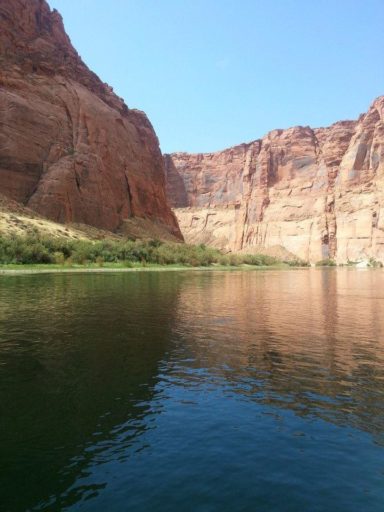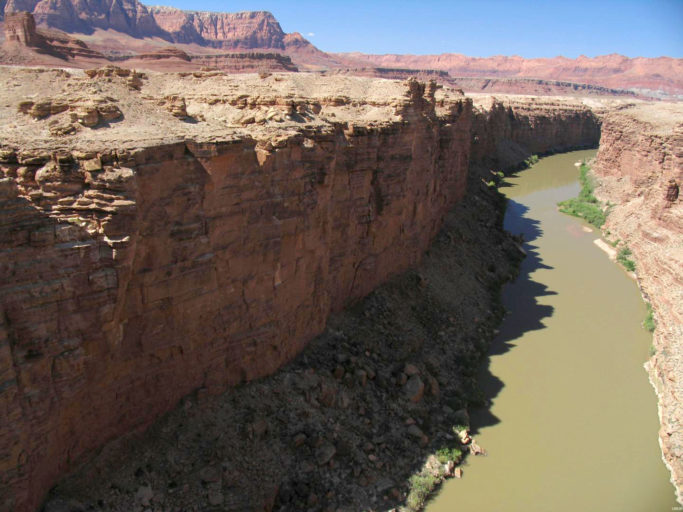- Colorado River flows were, on average, nearly 20 percent below the 1906-1999 average between 2000 and 2014, according to the study, published in the journal Water Resources Research earlier this month.
- That’s a reduction of about 2.9 million acre-feet of water per year. To put that in context: It’s been estimated that one acre-foot of water is the amount used by a family of four in one year.
- The multi-year drought in California receives far more press, but the Colorado River drought is just as severe and will also have far-reaching impacts, note the researchers with the University of Arizona (UA) and Colorado State University (CSU) who authored the study.
A new study suggests that Colorado River flows have already declined due to rising global temperatures and are likely to experience further declines in the future.
Colorado River flows were, on average, nearly 20 percent below the 1906-1999 average between 2000 and 2014, according to the study, published in the journal Water Resources Research earlier this month. That’s a reduction of about 2.9 million acre-feet of water per year. To put that in context: It’s been estimated that one acre-foot of water is the amount used by a family of four in one year.
Meanwhile, the two largest reservoirs in the United States, Lake Mead and Lake Powell, were both about 40 percent full in 2014, despite being at maximum volume in 2000, when an ongoing drought in the Colorado River basin first began.
The multi-year drought in California receives far more press, but the Colorado River drought is just as severe and will also have far-reaching impacts, note the researchers with the University of Arizona (UA) and Colorado State University (CSU) who authored the study.

Close to 40 million people in seven states in the western U.S. as well as two Mexican states rely on the Colorado River for their drinking water and to support their livelihood, according to the U.S. Department of the Interior’s Bureau of Reclamation.
“Fifteen years into the 21st century, the emerging reality is that climate change is already depleting Colorado River water supplies at the upper end of the range suggested by previously published projections,” the UA and CSU researchers write. “Record setting temperatures are an important and underappreciated component of the flow reductions now being observed.”
The study was aimed at quantifying the various effects of precipitation and temperature on Colorado River flows. The researchers said their findings suggest that temperatures 0.9 degrees Celsius (1.6 degrees Fahrenheit) higher than the average for the past 105 years in the Upper Basin of the Colorado River, from whence 85 percent of the river’s flow originates, were likely responsible for reducing river flows between 2.7 and nine percent during the study period. That amounts to anywhere from one-sixth to one-half of the total flow loss the Colorado River experienced during the 2000-2014 drought.
“This paper is the first to show the large role that warming temperatures are playing in reducing the flows of the Colorado River,” Jonathan Overpeck, Regents’ Professor of Geosciences and of Hydrology and Atmospheric Sciences at UA and one of the two authors of the study, said in a statement. “We’re the first to make the case that warming alone could cause Colorado River flow declines of 30 percent by midcentury and over 50 percent by the end of the century if greenhouse gas emissions continue unabated.”
Bradley Udall, a senior water and climate scientist at CSU’s Colorado Water Institute and Overpeck’s co-author, added that “The future of [the] Colorado River is far less rosy than other recent assessments have portrayed. A clear message to water managers is that they need to plan for significantly lower river flows.”
Overpeck and Udall note that “there is little doubt (i.e., high confidence) that temperatures will continue to increase as long as the emissions of greenhouse gases to the atmosphere continue.” They also state in the study, again with “high confidence,” that as temperatures in the region continue to climb, river flows will decline accordingly, anywhere from 11 percent to as much as 55 percent by end of century based on the temperature projections of moderate to high emissions scenarios.
The researchers also found that it is unlikely that precipitation in the Upper Basin will increase enough to offset the temperature-driven river flow declines, even in part. Furthermore, they say there is ample evidence of a significant risk that the Colorado River Basin will experience a megadrought — a drought that lasts 20 years or more — in the coming decades, even if climate change is halted. (The risk of a megadrought in the region rises substantially if global warming continues apace, of course.)
“The likelihood of drought and megadrought means that there will likely be decades-long periods with anomalously low runoff even if there is an increase in precipitation relative to the historical mean during some other periods due to anthropogenic climate change,” Overpeck and Udall write in the study. “Temperature-driven threats to the flows of the Colorado are thus large and real. The only way to curb substantial risk of long term mean declines in Colorado River flow is thus to work towards aggressive reductions in the emissions of greenhouse gases into the atmosphere.”
The Colorado River Basin saw unusually wet periods in the 1920s and 1990s, and those will still continue to occur, the two researchers write. But given that these wet periods will now be occuring at a time when higher temperatures are increasing the water demands from plants, soil, and humans, the river’s flows are unlikely to return to 20th-century averages if we don’t take immediate action, they argue.
“Current planning understates the challenge that climate change poses to the water supplies in the American Southwest,” Udall said. “My goal is to help water managers incorporate this information into their long-term planning efforts.”

CITATION
- Udall, B., & Overpeck, J. (2017). The 21st century Colorado River hot drought and implications for the future. Water Resources Research. doi:10.1002/2016WR019638
FEEDBACK: Use this form to send a message to the author of this post. If you want to post a public comment, you can do that at the bottom of the page.